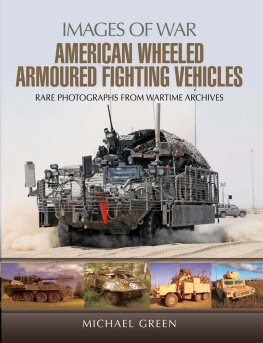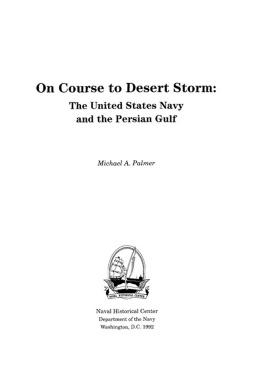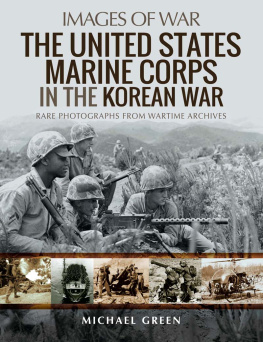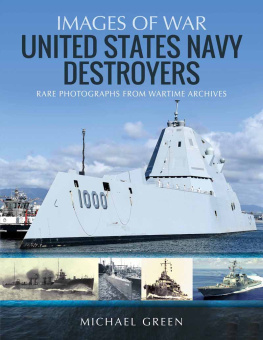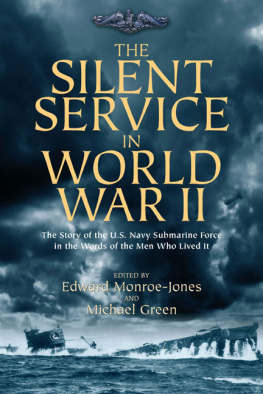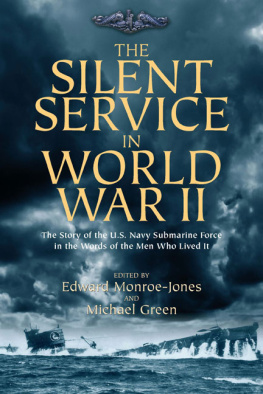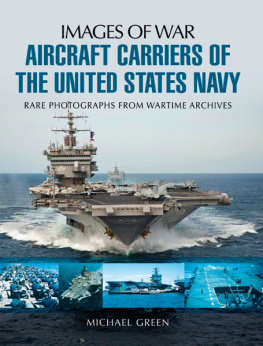Green Michael - United States Navy Submarines 1900-2019
Here you can read online Green Michael - United States Navy Submarines 1900-2019 full text of the book (entire story) in english for free. Download pdf and epub, get meaning, cover and reviews about this ebook. publisher: Pen & Sword Books Limited, genre: Romance novel. Description of the work, (preface) as well as reviews are available. Best literature library LitArk.com created for fans of good reading and offers a wide selection of genres:
Romance novel
Science fiction
Adventure
Detective
Science
History
Home and family
Prose
Art
Politics
Computer
Non-fiction
Religion
Business
Children
Humor
Choose a favorite category and find really read worthwhile books. Enjoy immersion in the world of imagination, feel the emotions of the characters or learn something new for yourself, make an fascinating discovery.
- Book:United States Navy Submarines 1900-2019
- Author:
- Publisher:Pen & Sword Books Limited
- Genre:
- Rating:5 / 5
- Favourites:Add to favourites
- Your mark:
- 100
- 1
- 2
- 3
- 4
- 5
United States Navy Submarines 1900-2019: summary, description and annotation
We offer to read an annotation, description, summary or preface (depends on what the author of the book "United States Navy Submarines 1900-2019" wrote himself). If you haven't found the necessary information about the book — write in the comments, we will try to find it.
United States Navy Submarines 1900-2019 — read online for free the complete book (whole text) full work
Below is the text of the book, divided by pages. System saving the place of the last page read, allows you to conveniently read the book "United States Navy Submarines 1900-2019" online for free, without having to search again every time where you left off. Put a bookmark, and you can go to the page where you finished reading at any time.
Font size:
Interval:
Bookmark:

IMAGES OF WAR
RARE PHOTOGRAPHS FROM WARTIME ARCHIVES
Michael Green

First published in Great Britain in 2019 by
PEN & SWORD MARITIME
An imprint of
Pen & Sword Books Ltd
47 Church Street
Barnsley
South Yorkshire
S70 2AS
Copyright Michael Green, 2019
ISBN 978-1-52674-206-3
eISBN 978-1-52674-207-0
Mobi ISBN 978-1-52674-208-7
The right of Michael Green to be identified as author of this work has been asserted by him in accordance with the Copyright, Designs and Patents Act 1988.
A CIP catalogue record for this book is available from the British Library.
All rights reserved. No part of this book may be reproduced or transmitted in any form or by any means, electronic or mechanical including photocopying, recording or by any information storage and retrieval system, without permission from the Publisher in writing.
Pen & Sword Books Limited incorporates the imprints of Atlas, Archaeology, Aviation, Discovery, Family History, Fiction, History, Maritime, Military, Military Classics, Politics, Select, Transport, True Crime, Air World, Frontline Publishing, Leo Cooper, Remember When, Seaforth Publishing, The Praetorian Press, Wharncliffe Local History, Wharncliffe Transport, Wharncliffe True Crime and White Owl.
For a complete list of Pen & Sword titles please contact
PEN & SWORD BOOKS LIMITED
47 Church Street, Barnsley, South Yorkshire S70 2AS, England
E-mail:
Website: www.pen-and-sword.co.uk
The author would like to dedicate this book to all the US Navy submariners who volunteered to serve in wartime and peacetime.
I n 1900 the US Navy took into service its first submarine. Named the Holland VI , it was 53ft 10in in length and had a surface displacement of 65 tons. The maximum surface speed was 6 knots and submerged speed 5.5 knots. Power came from a gasoline engine on the surface and a storage battery when underwater. Armed with a single torpedo tube and three torpedoes, it could submerge to a depth of 75ft.
During the Second World War, it would be the US Navys Gato - and Balao -class fleet submarines that would send the bulk of the Japanese merchant fleet to the bottom of the ocean as well as accounting for a large number of Japanese warships. They averaged approximately 312ft in length with a surface displacement of about 1,500 tons and could submerge to a depth of 400 feet.
Manned by a crew of up to eighty men, the Gato - and Balao -class fleet submarines had a maximum surface speed of 20 knots and 8.75 knots submerged. A diesel-electric drive propulsion system provided power. Armed with ten torpedo tubes, six forward and four in the bow, they carried into battle twenty-four torpedoes and a variety of deck guns.
Jump forward to 1981, when the first of eighteen Ohio -class submarines entered US Navy service. At 560ft long and 42ft wide, these had an underwater displacement of 21,000 tons. Manned by a crew of 155, their submerged speed is rumoured to be almost 30 mph. Nuclear-powered, they can remain underwater for decades, surfacing only to replenish supplies. Their main armament of sixteen nuclear warhead-armed missiles has a range of 4,600 miles. Speculation is that the Ohio -class can reach a depth of more than 1,000ft.
This Images of War title presents a graphic overview of all the US Navys submarine classes beginning with the Holland VI through to the Ohio -class and beyond, both in text and in historical and contemporary images.
T he historical images in this book are all non-copyrighted US Navy images from a variety of sources. These include the National Archives and the Naval Historical Center. Additional images of US Navy submarines can be found online at www.navsource.org
Images of contemporary US Navy submarines come from various Department of Defense (DOD) image websites. Friends have provided additional images of preserved US Navy submarines. As with all published works, authors depend on many friends for assistance in reviewing their work.
Due to the format restrictions imposed by the publisher for this series of books, the amount of detail is not comprehensive. Reflecting the long time span covered by this subject, the author offers only a very broad overview.
All weights in tons refer to short tons and not imperial tons.
The US Navy often repeated names for individual submarines and class names over their many decades.
Design and operational parameters, as well as crew complement, could vary widely over the lifespan of submarine classes and individual vessels within those classes. Hence the information listed in this work for submarine classes and individual submarines represents only a certain point in their service life.
Sources do vary on the division of US Navy submarine fleet boat classes. The author has chosen to base his breakdown on the book titled The Fleet Submarine in the US Navy: A Design and Construction History by Commander John D. Alden (retired), published by the Naval Institute Press and first printed in 1979.
I t took the invention of many crucial pieces of technology for submarines to become practical. The most important was the electrical storage battery (1859), the self-propelled torpedo (1866), and the gasoline engine (1876), followed by the DC electric motor (1886) and AC electric motor (1899). The two men responsible for bringing these technologies together for submarine designs were American school-teacher and inventor John Philip Holland and mechanical engineer and naval architect Simon Lake.
Of these two submarine-design pioneers, Holland won the first US Navy submarine-construction contract because he had the financial backing that Lake did not. The submarine as per US Navy requirements had to be steam-powered for surface-running and battery-powered for underwater-running. Realizing that steam-propulsion was impractical for submarines, Holland abandoned work on a submarine ordered by the US Navy named the Plunger and returned his advance payment.
Even before Holland lost interest in the development of the Plunger , he had turned his attention to building a series of self-funded submarine designs. The last launched in May 1897 received the designation Holland VI . A gasoline engine powered it on the surface, while underwater the submarine operated with an electric motor driven by storage batteries.
Impressed by what they saw, the US Navy purchased the Holland VI in April 1900 and after a series of successful tests designated the submarine the USS Holland in October 1900. It lasted in US Navy service until November 1910. The prefix letters USS before a vessels name stand for United States Ship.
The six-man Holland had a small dome projecting above the hull but no periscope. The only vision the crew had was a small thick pane of glass in that dome. Holland s armament consisted of a single reloadable 18in-diameter torpedo tube. At that time torpedoes were generally referred to as automotive torpedoes or fish torpedoes.
Initially, the Holland had two compressed air guns, one on either end of its hull, referred to as Dynamite Guns and later reduced to a single example. The projectiles they fired when the submarine surfaced became known as aerial torpedoes.
Font size:
Interval:
Bookmark:
Similar books «United States Navy Submarines 1900-2019»
Look at similar books to United States Navy Submarines 1900-2019. We have selected literature similar in name and meaning in the hope of providing readers with more options to find new, interesting, not yet read works.
Discussion, reviews of the book United States Navy Submarines 1900-2019 and just readers' own opinions. Leave your comments, write what you think about the work, its meaning or the main characters. Specify what exactly you liked and what you didn't like, and why you think so.


